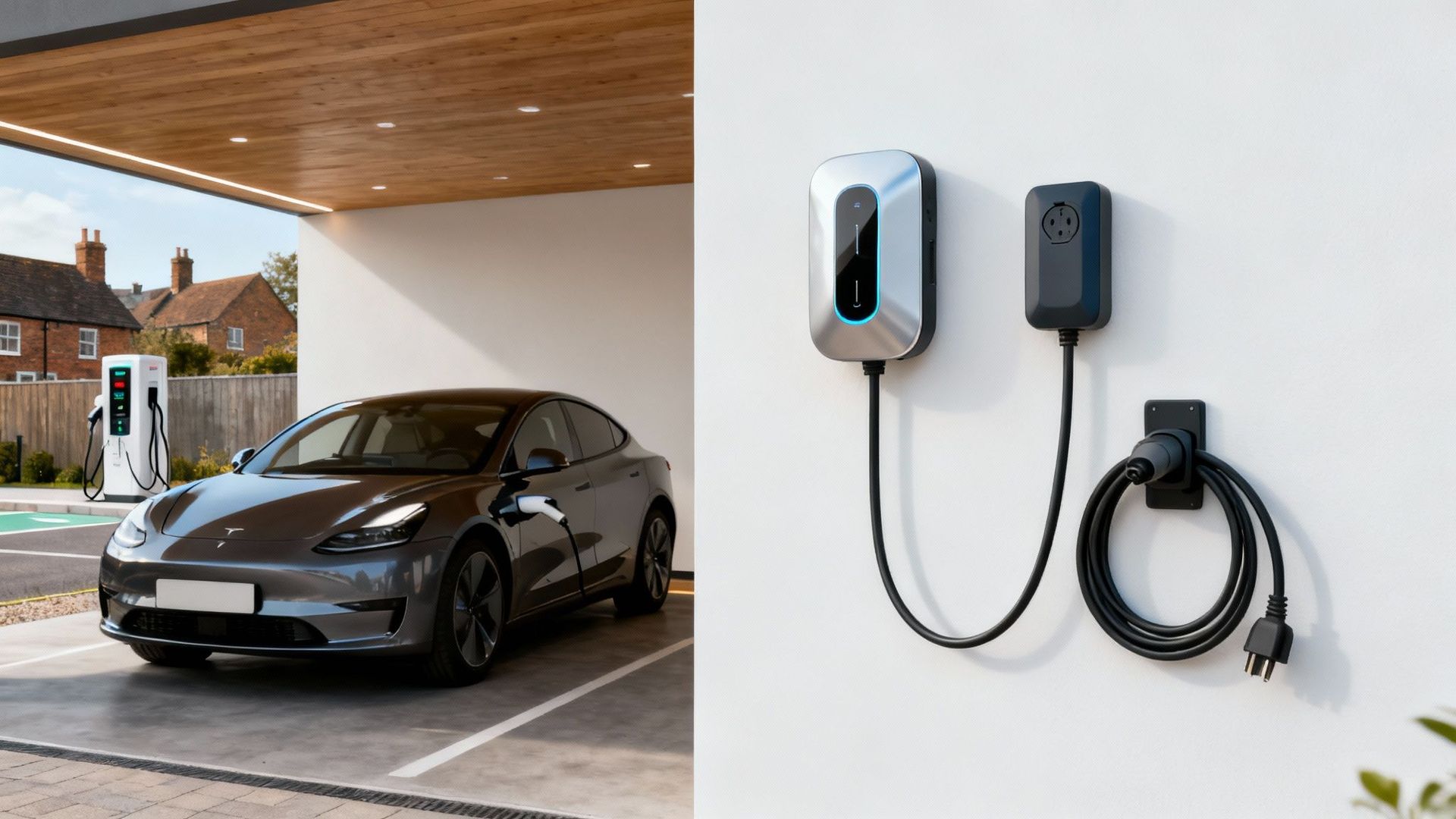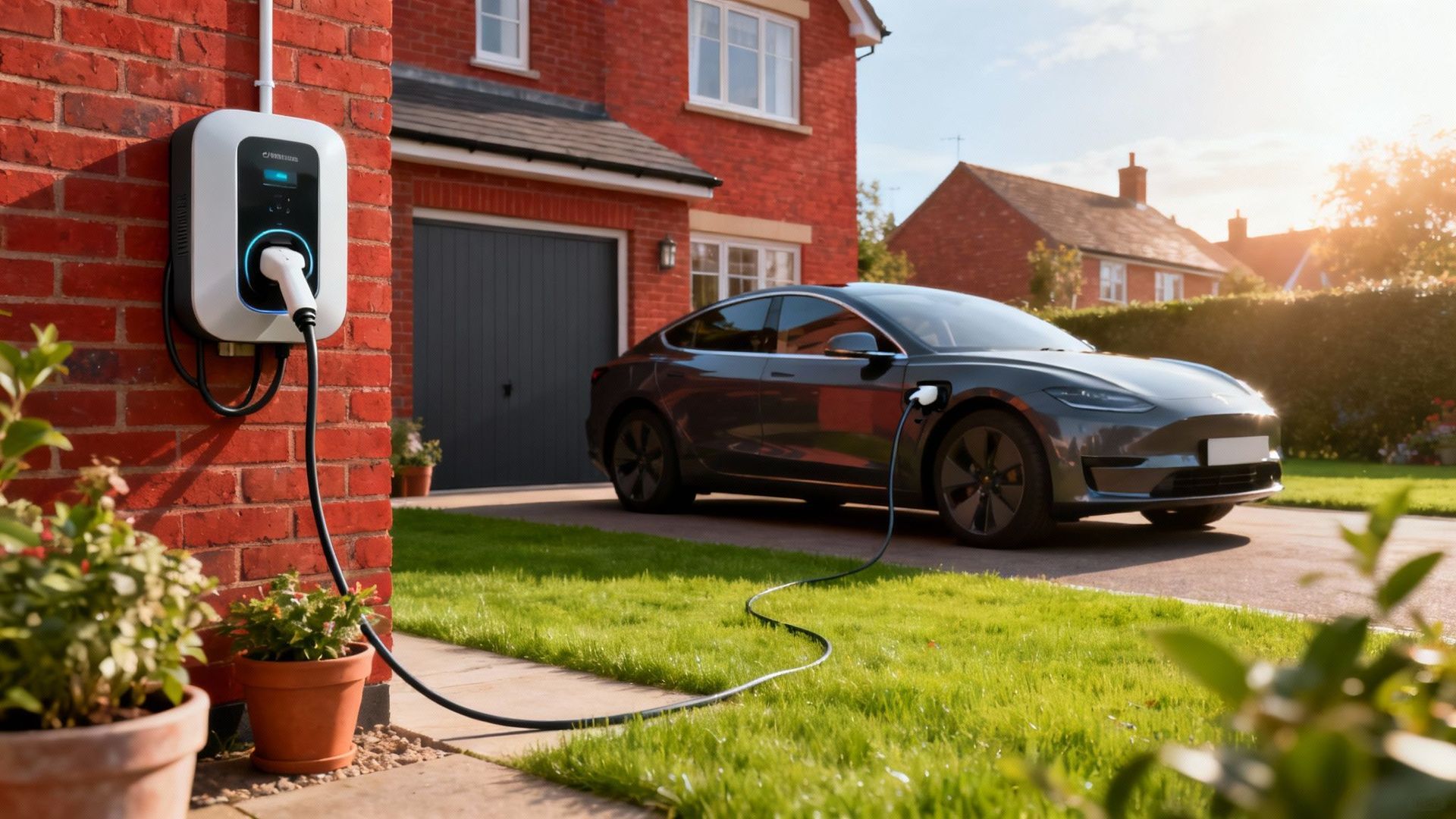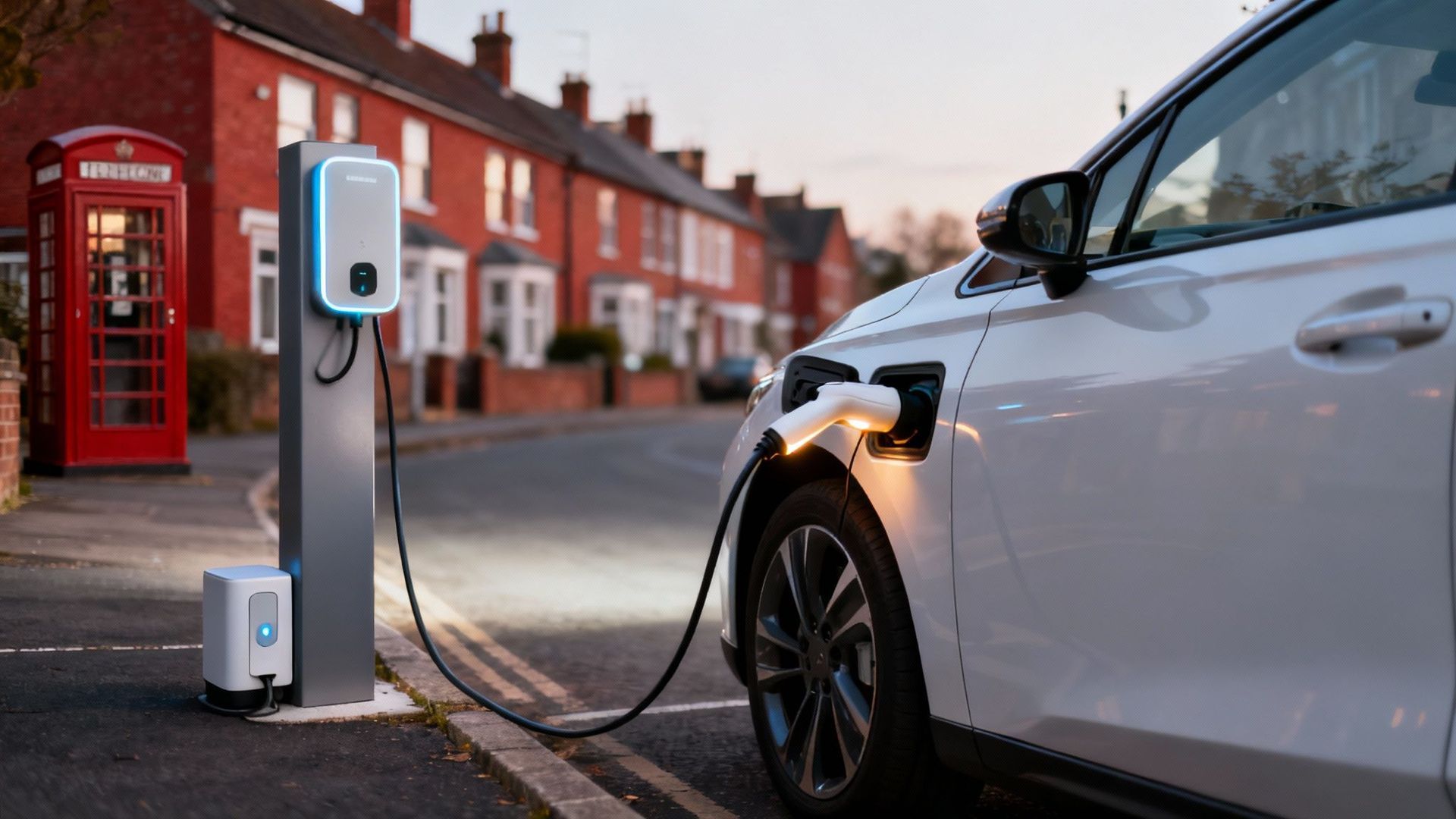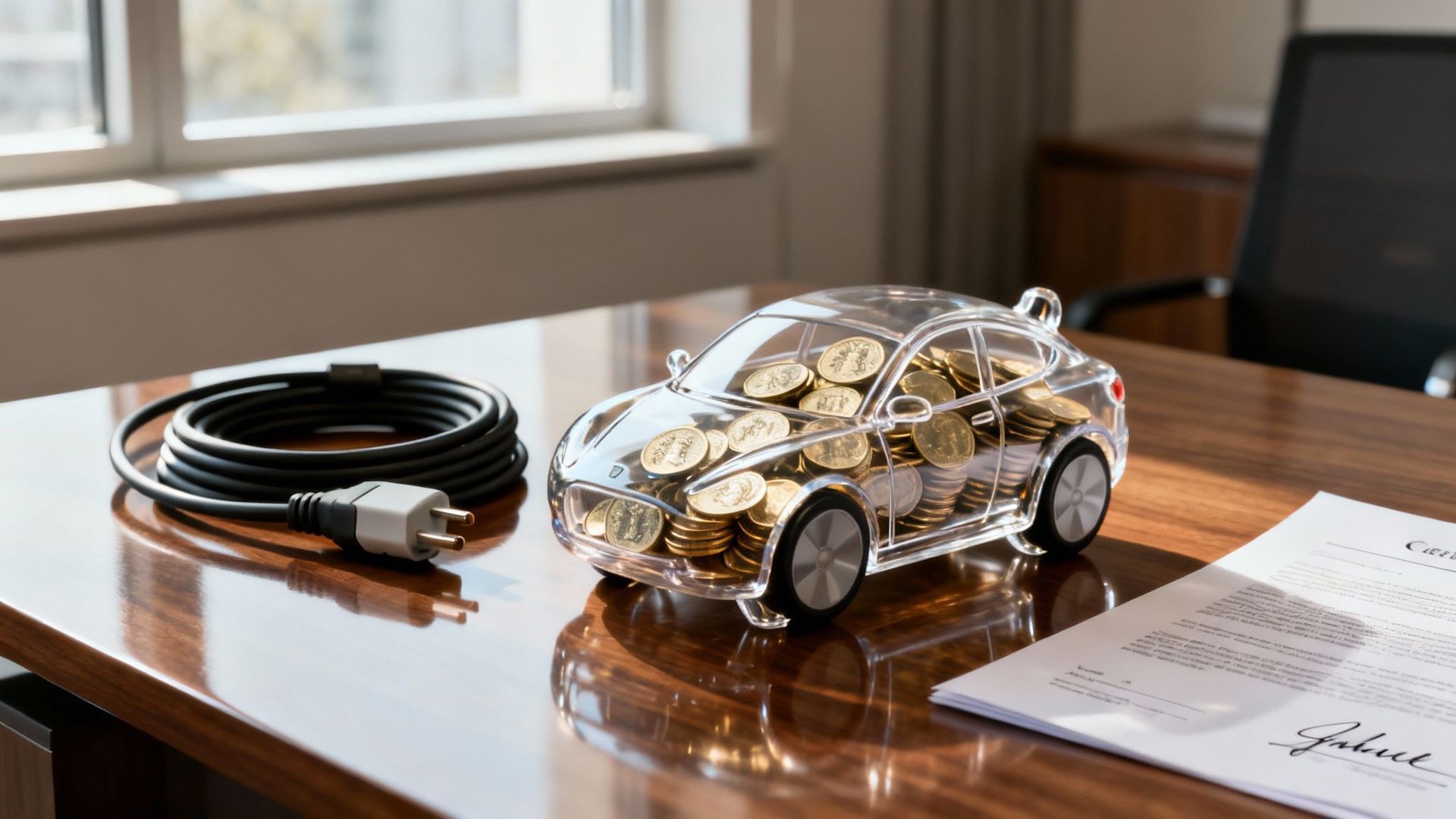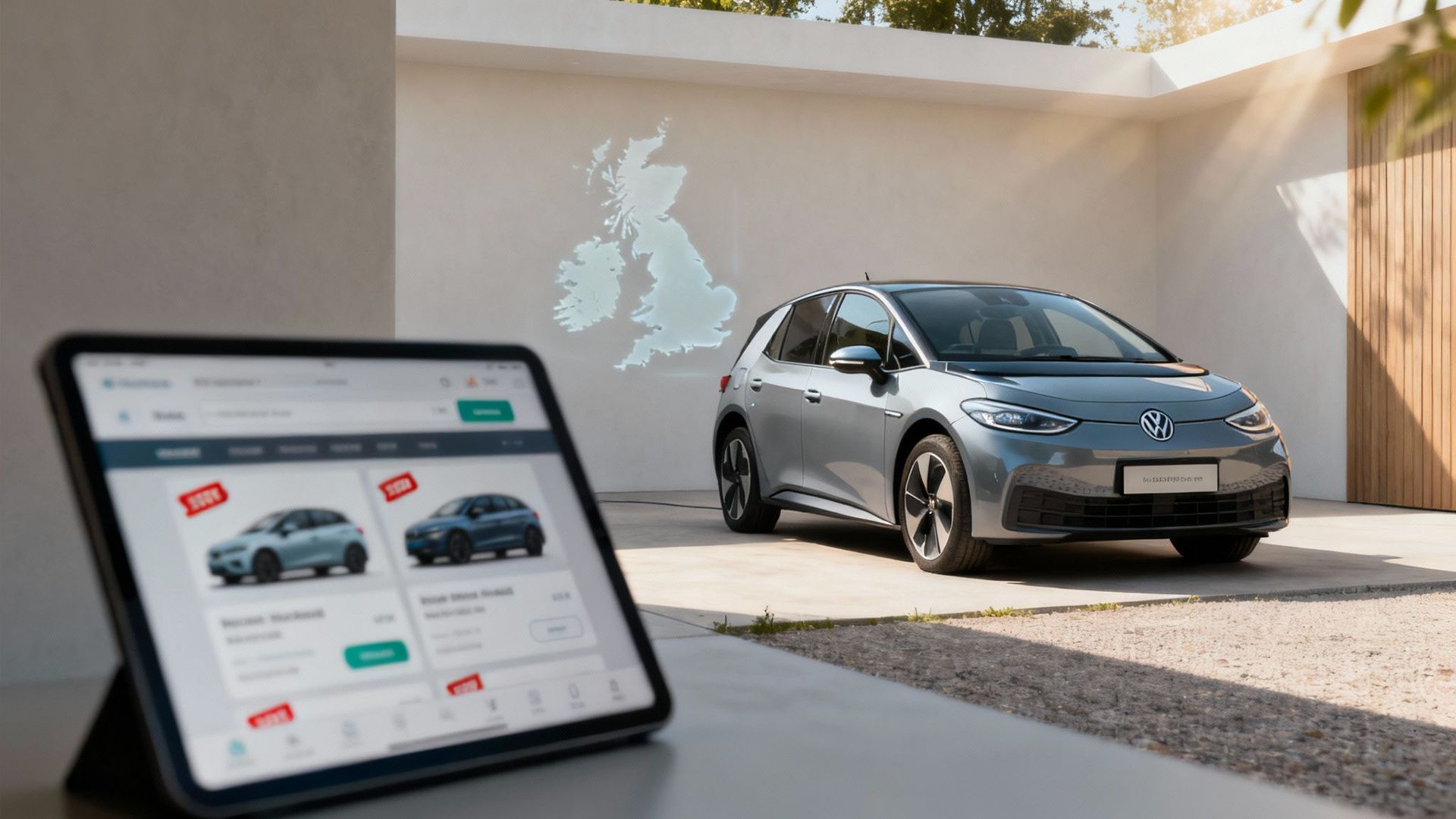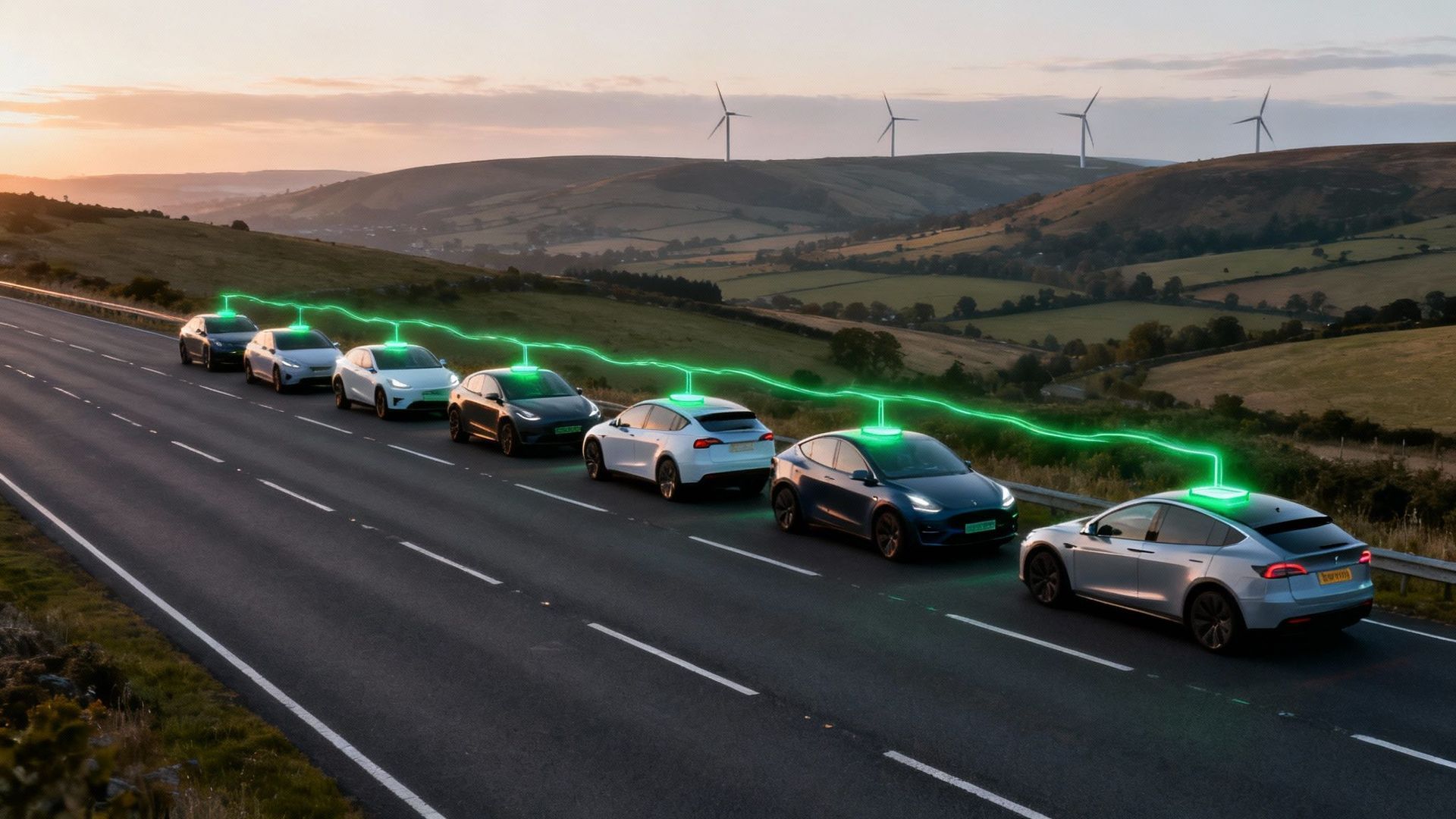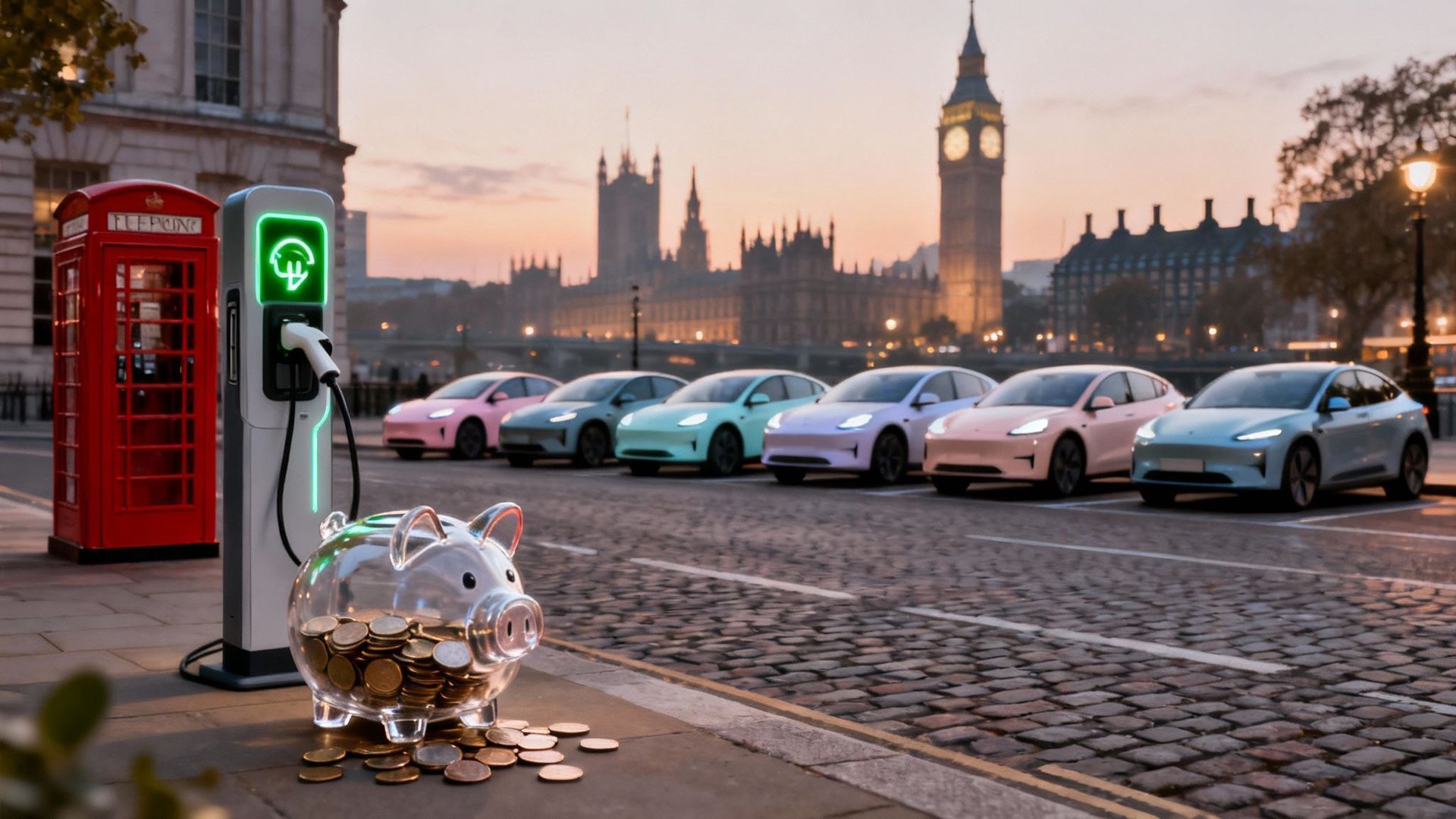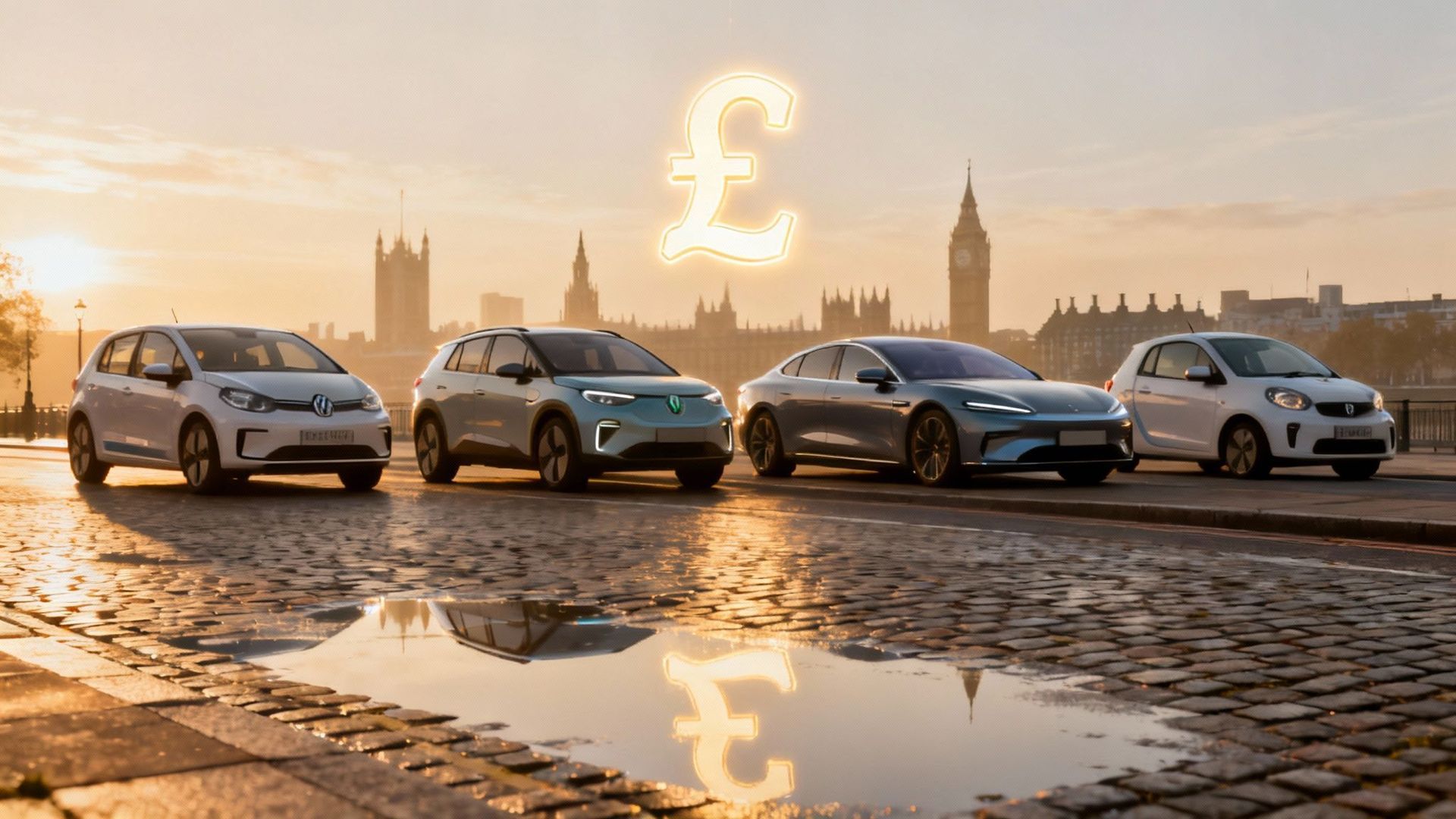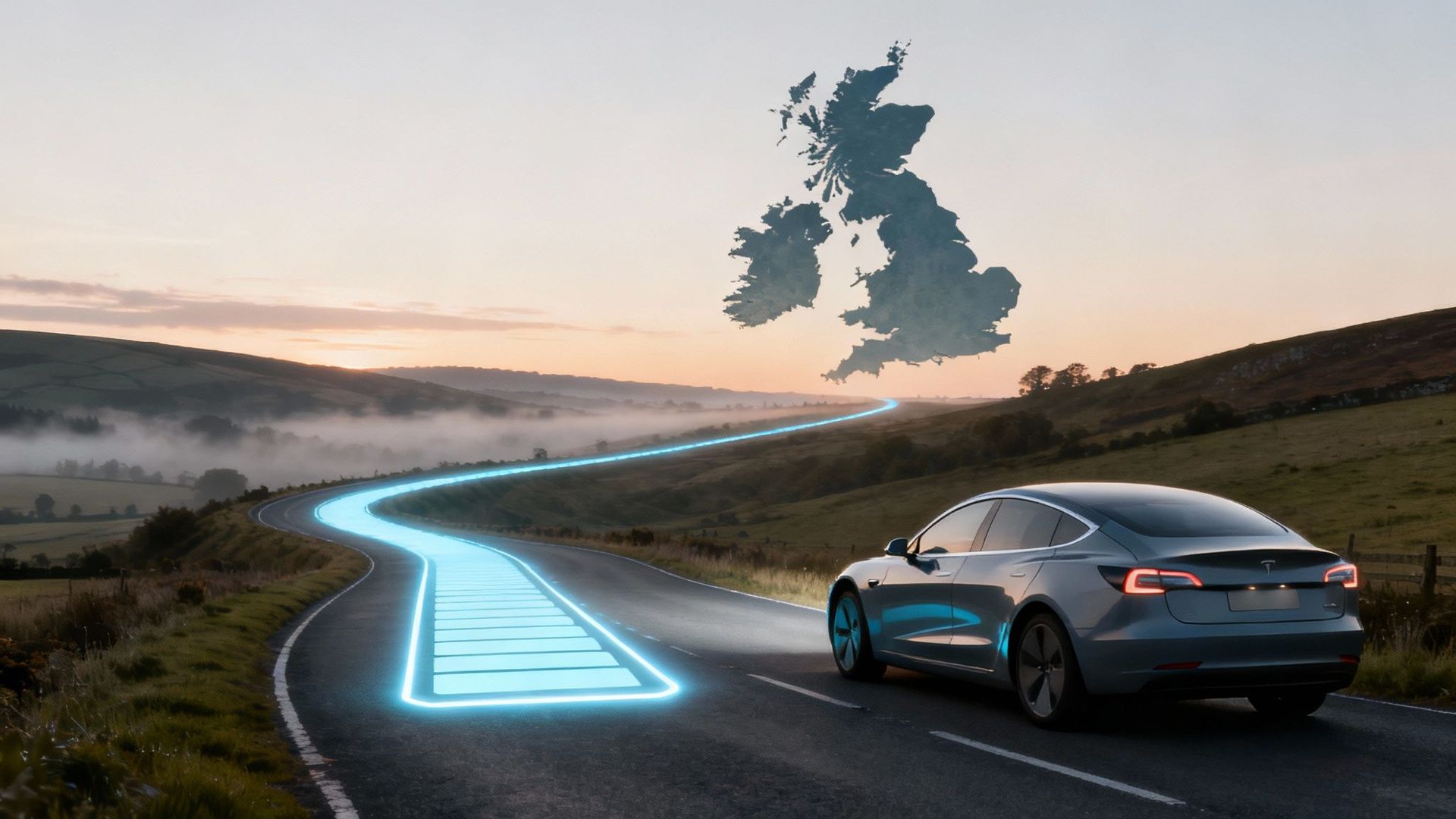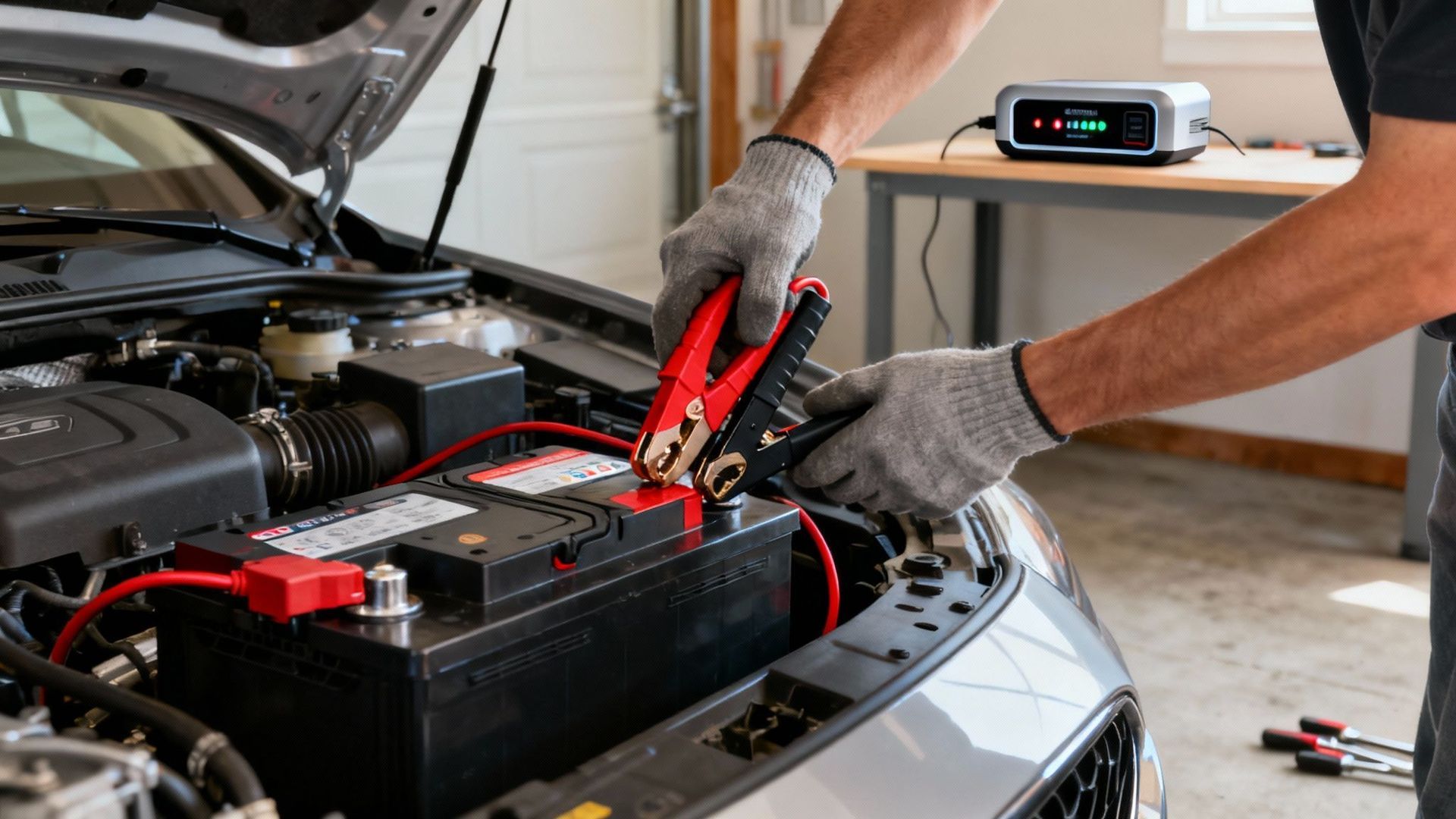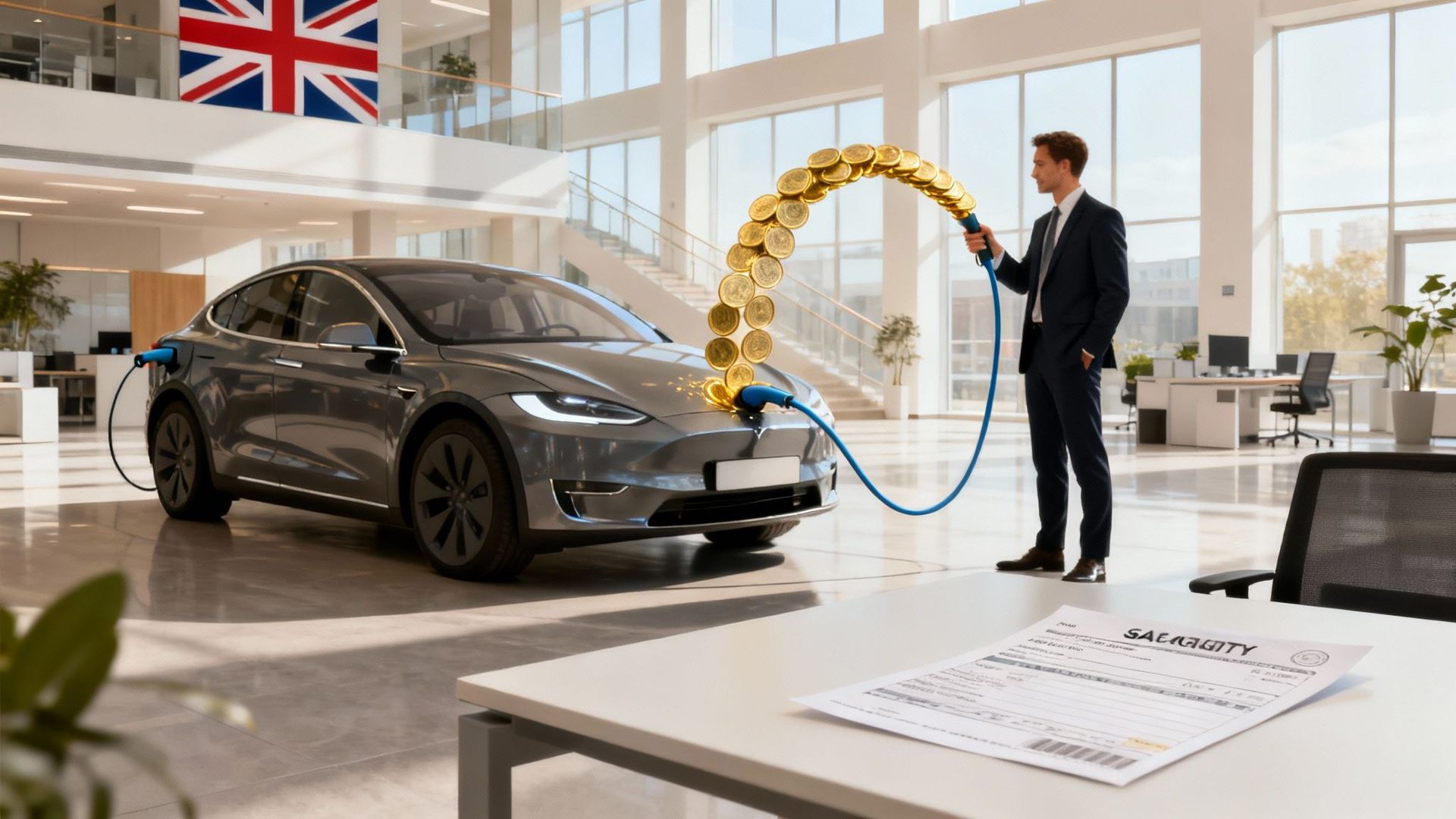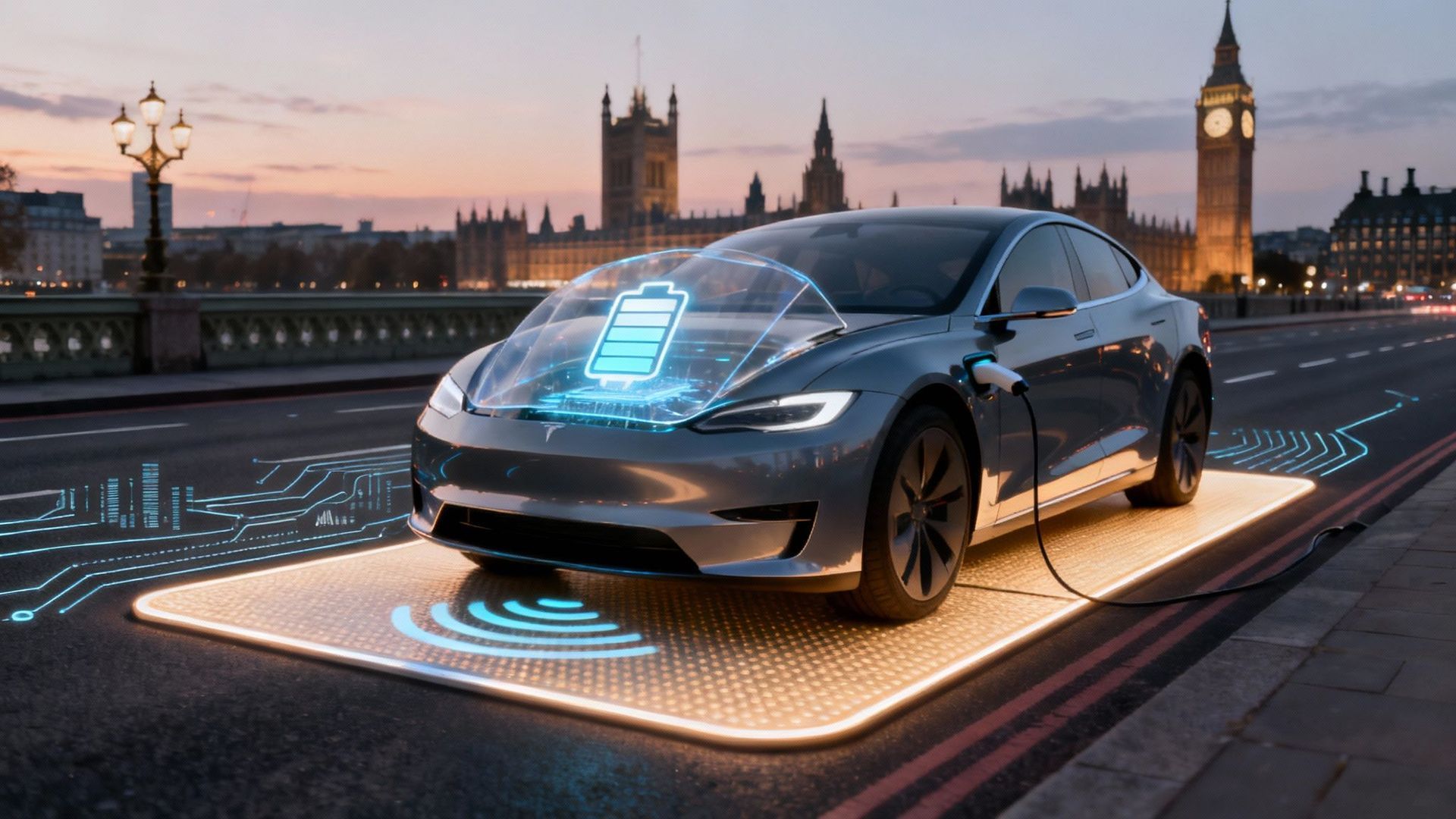How Hybrid Cars Actually Work: A Simple Guide for Blokes and Birds
So, what’s actually going on under the bonnet of a hybrid car? Forget the complicated jargon for a moment; this isn't rocket science, it's just clever motoring. At its heart, a hybrid is simply a car that uses a tag team of power sources: a familiar, oily petrol engine and a modern, silent electric motor.
Think of them as a classic double act. The zippy electric motor takes over for the low-speed, stop-start drudgery of city traffic—precisely where a traditional petrol engine is at its most wasteful, gulping fuel like a fresher during O-Week. Then, when you need a bit more poke on the open road, the petrol engine seamlessly steps in to do the heavy lifting. It's a proper partnership.
So, How Does This Witchcraft Actually Work?

The real magic of a hybrid isn't just having two engines; it's how the car intelligently switches between them without you spilling your tea. This whole operation is orchestrated by a sophisticated onboard computer that acts like a very efficient, slightly nerdy manager.
This digital brain constantly analyses what you’re doing—how fast you're going, how hard you're stamping on the accelerator, and the battery's charge level. Based on this, it decides in a split second whether to use the petrol engine, the electric motor, or a blend of both to give you the best possible efficiency without you even noticing. It’s this clever juggling act that squeezes every last drop out of your tank of petrol.
The Self-Charging Secret (It's Not Actually a Secret)
One of the biggest questions people have about hybrids is, "Do I need to plug the bloody thing in?" For a standard hybrid (often called a 'self-charging hybrid' by marketing bods), the answer is a simple no . You never have to worry about finding a charging point or trailing cables across the pavement like some sort of suburban trip hazard.
The car tops up its own battery using a clever trick called regenerative braking .
Every time you lift your foot off the accelerator or press the brake pedal, the system captures the car's momentum. Instead of that energy being wasted as heat through the brake pads—which is utterly useless unless you want to warm a pasty—it's converted into electricity and sent straight back to the battery.
It’s a bit like recycling energy on the go. This means you just fill it up with petrol like any normal car, and the hybrid system takes care of all the complex energy management in the background. You just drive. Simple as that.
This approach gives hybrids a few clear benefits over a standard petrol car:
- Better Fuel Economy: By letting the electric motor handle the inefficient bits of driving, hybrids use significantly less fuel, especially around town. Your wallet will thank you.
- Reduced Emissions: Burning less fuel directly translates to lower CO2 emissions from the tailpipe, making them a greener choice and saving you from the righteous fury of your eco-conscious neighbours.
- A Quieter Drive: The ability to pull away from the lights in near silence and cruise at low speeds on electric power makes for a much more relaxing and refined driving experience. Less racket, more refinement.
In short, a hybrid is a smarter, more efficient petrol car. It gives you a taste of electric driving without asking you to change a single thing about how you refuel or use your car.
The Core Components Inside a Hybrid Car
To really understand what makes a hybrid tick, we need to pop the bonnet and look at the team of components working together under the metal. It’s less of a perfectly synchronised orchestra and more like a brilliant, slightly chaotic pub band where every member knows their part instinctively. Think of it as a mechanical partnership, with each bit playing a vital role in getting you from A to B without making you wince every time you visit a petrol station.
Let's shove the complex engineering diagrams aside for a second. At its heart, a hybrid system is simply a clever blend of old-school muscle and new-school intelligence.
The Familiar Face: The Petrol Engine
First up is the Internal Combustion Engine (ICE) , the loud, oily heart of motoring we’ve known for over a century. This is your traditional petrol-powered workhorse, delivering the grunt you need for motorway speeds and those moments when you need to accelerate with a bit of purpose. In the hybrid team, it's the grizzled veteran—powerful and dependable, but not a big fan of stop-start city traffic where it tends to get a bit thirsty.
The great thing is, in a hybrid, the engine doesn't have to go it alone. This means carmakers can often fit smaller, more efficient engines—think a downsized 1.5-litre instead of a beefier 2.0-litre —because it has an electric sidekick ready to lend a hand when the going gets tough.
The Silent Partner: The Electric Motor
Next, meet the Electric Motor —the cool, quiet, and incredibly efficient newcomer. Unlike a petrol engine that needs to spin up to deliver its power, an electric motor gives you all its pulling power (or torque ) the instant you touch the pedal. This is what gives hybrids that satisfying, silent push off the line at traffic lights, leaving many other drivers wondering what just happened.
The motor truly shines in town. It handles all the low-speed crawling and creeping in traffic, situations where a petrol engine would just be wastefully chugging fuel. It’s a multi-talented performer, too, as it can reverse its role and become a generator when you brake. We'll get to that clever trick in a bit.
The Power Bank: The Battery Pack
Of course, that electric motor needs a supply of electricity, and that comes from the High-Voltage Battery Pack . This isn't the little 12V battery that starts your car; it's a much larger and more sophisticated unit, usually made of lithium-ion cells, similar to what’s in your smartphone but on a massive scale. It's the energy reservoir, storing power to keep the electric motor ready for action.
This battery is central to a hybrid's efficiency. It stores recycled energy captured during braking and also holds onto any surplus power generated by the engine. Battery technology is moving forward at a blistering pace, and you can see how far it's come by exploring new battery tech on two wheels, which often serves as a testbed for innovation. It's also built to last the life of the car, busting the old myth that you'll face a colossal replacement bill after a few years.
The Brains of the Operation: The Power Control Unit
Finally, there’s the unsung hero of the whole setup: the Power Control Unit (PCU) . If the engine provides the brawn and the motor is the silent assassin, the PCU is the conductor making sure everything happens at the right time. This sophisticated computer is the real genius behind how a hybrid vehicle works.
The PCU is constantly making thousands of calculations every second. It decides whether to use the engine, the motor, or both. It figures out when to charge the battery and how to send power to the wheels in the most efficient way possible.
This is why the whole process feels so seamless from behind the wheel. As the driver, you’re completely unaware of the intricate mechanical dance happening beneath your feet. All you notice is a smoother drive and fewer trips to the pump. This clever box of electronics is what elevates a hybrid from being just a car with two power sources into a genuinely smart machine.
Understanding Series, Parallel, and Power-Split Hybrids
Right, so you've met the key players under the bonnet—the engine, motor, battery, and the all-important control unit. But knowing the cast list is one thing; understanding the plot is another. Not all hybrids are created equal. In fact, they come in three distinct flavours, each with its own peculiar way of blending petrol and electric power.
Think of it this way: asking how a hybrid works is a bit like asking how a bicycle works. The basic idea is the same, but a simple pushbike, a tandem, and a high-tech racing bike all get the job done very differently. The same goes for hybrid cars. The way they combine their power sources fundamentally changes how they feel to drive and where they are most efficient.
This infographic breaks down the core components that are rearranged into these different hybrid architectures.

This map shows how the engine, motor, battery, and control unit are the central building blocks, managed by the control unit to achieve different driving characteristics.
The Series Hybrid: The Onboard Power Station
Let's start with the oddball of the group: the series hybrid . In this setup, the petrol engine has absolutely no physical connection to the wheels. None whatsoever. Its one and only job is to act as a generator, producing electricity to power the electric motor, which then drives the wheels.
Imagine you have a petrol generator in your boot to power an electric fan. That's essentially a series hybrid. The engine whirs away creating juice, and the electric motor uses that juice to push you along. This setup means the car always feels like an electric vehicle, with that smooth, instant acceleration, because it is always driven by the electric motor.
The engine is purely a range extender, kicking in when the battery needs a top-up. You get an EV-like driving experience without the range anxiety, as you can just pop into a petrol station.
This design is less common in mainstream cars but is brilliant for specific uses where the engine can be run at its most efficient, constant speed, like a generator chugging away in the background.
The Parallel Hybrid: The Tag Team Champions
This is the most common type of hybrid you'll find on UK roads. A parallel hybrid is what most people picture when they think about how hybrid vehicles work. Here, both the petrol engine and the electric motor can be connected to the wheels, and they can work together or independently.
Think of it as a tandem bicycle with two riders. Sometimes, the strong rider (the engine) does all the work. On gentle slopes, the other rider (the motor) can take over completely. But when you need to tackle a steep hill, they both pedal furiously together for maximum power.
- Low Speeds: The electric motor handles pulling away and cruising through town.
- Cruising: The petrol engine takes over for efficient motorway driving.
- Hard Acceleration: Both power sources combine their might for a satisfying shove in the back.
This flexibility makes parallel hybrids a fantastic all-rounder, capable of delivering great fuel economy in a wide range of driving conditions. Their popularity reflects this versatility, which is a major factor in the UK's growing hybrid market. In fact, forecasts predict the market will expand at a rate of 17.6% annually, potentially hitting 1.92 million units sold each year by 2034. You can explore more data on this trend by reading the full UK hybrid vehicle market research.
The Power-Split Hybrid: The Master Juggler
Finally, we arrive at the brainiest and most complex of the trio: the power-split hybrid . Popularised by Toyota in the Prius, this system is the clever clogs of the hybrid world. It uses a fiendishly clever piece of engineering—a planetary gearset—to constantly blend power from both the engine and the electric motor.
Instead of just switching between power sources, it can send power in multiple directions at once. It can use the engine to drive the wheels while simultaneously siphoning off some of that power to charge the battery. Or it can combine power from the engine and motor to drive the wheels for a boost.
It’s like having a master chef in your kitchen who can mix ingredients in endless combinations to create the perfect dish for any occasion. This system continuously adjusts the power blend to keep the engine in its absolute sweet spot for efficiency, no matter what your right foot is doing. This is why these cars are famously fuel-sipping, especially in mixed driving. It’s the ultimate expression of the hybrid concept.
A Day in the Life of a Hybrid Driver

All that theory about series, parallel, and power-split systems is well and good, but what does it actually feel like to drive a hybrid? How do those clever systems translate to your dreary Monday morning commute or a weekend dash to the supermarket?
Let's walk through a typical day to see how a hybrid operates in the real world. This will finally make sense of that colourful power-flow animation you see on the dashboard.
The day begins with you needing to get out of your parking space. You press the start button, and… nothing. Just a quiet chime and a green 'Ready' light. This is your first taste of the hybrid experience: pulling away in almost complete silence. This is EV Mode , where the car uses only the electric motor, powered by the battery. It’s perfect for creeping out of your street without waking the neighbours.
Navigating the Urban Jungle
As you join the morning crawl, the hybrid truly comes into its own. At the first set of traffic lights, you pull away silently again, with the electric motor providing that instant, smooth acceleration. Right now, you’re using zero petrol.
When the traffic inevitably grinds to a halt, the petrol engine stays off. No idling, no noise, and no wasted fuel. This is where hybrids absolutely thrash conventional cars on fuel economy.
Suddenly, a gap appears and you need to merge quickly. You press the accelerator a bit more firmly, and with a transition so seamless you barely notice, the petrol engine quietly awakens and joins the party. The car’s brain has decided you need more grunt than the electric motor can provide on its own. It’s a smooth handover, not a jarring lurch.
The most magical part of city driving is regenerative braking . Every time you slow down for a junction, a roundabout, or a pedestrian glued to their phone, the car captures the braking energy. Instead of being wasted as heat, this energy is converted back into electricity and sent to the battery, topping it up for free.
You’re literally refuelling your car just by slowing down. It’s this constant cycle of using and recapturing energy that makes hybrids so ridiculously efficient in stop-start traffic.
Hitting the Open Road
Leaving the city behind, you merge onto a dual carriageway. As you accelerate up the slip road, the petrol engine takes the lead. At a steady cruising speed, the engine is at its most efficient, so the car relies on it to do the heavy lifting. The electric motor takes a back seat, and your dashboard display will likely show the engine driving the wheels directly.
But then you get stuck behind a tractor. Time to overtake. You floor it, and this is where you experience Boost Mode .
- The petrol engine fires up with maximum effort.
- Simultaneously, the electric motor kicks in with its instant torque.
- The combined power from both sources gives you a satisfying surge of acceleration, propelling you past the obstacle with surprising urgency.
Once you’re safely past and settle back to a cruise, the system relaxes. The electric motor disengages, and the petrol engine might even use this moment to send a little surplus energy back to the battery, making sure it’s ready for the next time it’s needed.
The Motorway Myth and the Journey Home
On a long, clear motorway run, a hybrid behaves much like a conventional petrol car. The engine will be doing almost all the work, as there are very few opportunities for braking to regenerate energy. This is why a modern diesel can sometimes be more economical on a purely motorway journey; the hybrid's advantages are less pronounced when it can’t flex its electric muscles.
Finally, as you pull back onto your street at the end of the day, the car switches back to silent EV Mode . You glide into your driveway, the engine having switched off a hundred metres back.
You've navigated city traffic, accelerated onto fast roads, and cruised on the motorway, all while the car's brain juggled its power sources perfectly. Best of all? You've saved fuel, enjoyed a quieter drive, and never once had to think about how it all works. You just drove.
Busting the Biggest Hybrid Car Myths
Step into any pub in Britain, and you’re guaranteed to overhear three things: a debate about a dodgy VAR decision, someone complaining about the price of a pint, and a self-proclaimed expert spouting absolute codswallop about hybrid cars. It's a national pastime.
Misinformation about hybrids spreads faster than office gossip. From worries about battery life to their supposed lack of oomph, these myths are often based on tech that's a decade out of date or just pure guesswork. It's time to arm you with the facts so you can politely, but firmly, shut down the next person who tries to tell you your hybrid is a glorified milk float.
Myth 1: You Have to Plug Them In, Don't You?
Let’s get the big one out of the way first. "So, you have to plug it in every night? What a faff!" This is probably the most common misunderstanding, lumping all hybrids into one inconvenient basket. The short answer? No, you don't.
For a standard 'self-charging' hybrid, the kind most people drive, there's no plug, no cable, and no need to fight for a space at the supermarket chargers. The car is a self-contained system, cleverly topping up its own small battery using energy captured during braking and from any surplus power the engine produces. You just fill it with petrol like any other car and let the technology do the rest.
The cars that do need plugging in are Plug-in Hybrids (PHEVs) , which are a different beast altogether. They have much larger batteries designed for a decent electric-only range, but a standard hybrid is entirely self-sufficient.
Of course, the government is getting wise to how people use PHEVs, and there's a push for more accurate CO2 measurements. You can learn more about how the EU plans to give plug-in hybrids real-world CO2 measurements in our related article.
Myth 2: The Batteries Die Quickly and Cost a Fortune
Ah, the classic scare story. "That battery will only last five years, mate. Cost you five grand to replace it!" This myth is a hangover from the early days of hybrid tech, and it simply isn't true anymore. Hybrid batteries are not like the one in your old phone that gives up the ghost if you look at it funny.
Manufacturers design these high-voltage battery packs to last the entire lifespan of the vehicle. They go through ridiculously tough testing and come with long warranties—often for eight years or 100,000 miles —for your peace of mind. While a replacement would be expensive, outright failure is incredibly rare. Honestly, you're far more likely to face a bill for a new clutch or gearbox on a conventional car than you are for a hybrid battery.
Myth 3: They're Slow and Boring to Drive
This one is for anyone who thinks 'hybrid' is just another word for 'sluggish'. Tell that to the McLaren P1, Porsche 918, or LaFerrari—all hybrid hypercars that use electric motors for face-melting acceleration. Now, while your family SUV won't quite match those, the principle is the same.
The instant torque from the electric motor gives hybrids a surprising zip off the line, especially where it counts in normal driving.
- In the city: They feel much quicker and more responsive at low speeds than many petrol-only equivalents.
- When overtaking: The 'boost' from the motor kicking in alongside the engine provides a satisfying surge of power exactly when you need it.
There's a reason hybrids have become such a dominant force in the UK market. In the first nine months of a recent year, 222,669 hybrid electric vehicles were registered, grabbing a 14.1% market share—an 8.6% increase from the year before. People aren't buying them because they're boring; they're buying them because they're a smart, efficient, and surprisingly enjoyable drive. Discover more insights about UK new car market trends on Autovista24.
Frequently Asked Questions About Hybrid Cars
Right, you’ve sat through the theory, endured the analogies, and hopefully now have a decent grasp of how hybrid vehicles work. But let’s be honest, there are probably a few nagging questions still bouncing around your head. This is the quick-fire round where we tackle those common queries with straight answers, no fluff, and absolutely no engineering jargon.
Think of this as the pub-quiz cheat sheet for hybrid ownership. Here’s everything you need to know to sound like you’ve got it all figured out.
Are Hybrids Expensive to Maintain?
This is a classic, usually trotted out by someone trying to justify their 15-year-old diesel. The short answer is: not really. In fact, in some ways, they can be cheaper to look after.
Your routine servicing—oil changes, filters, and the like—will cost about the same as any comparable petrol car. The big win for hybrids comes from the magic of regenerative braking. Because the electric motor does a lot of the initial slowing down, your brake pads and discs get a much easier life. This means they often last significantly longer, saving you a tidy sum on one of the most common wear-and-tear jobs.
Of course, the technology is more complex. If something goes wrong with the high-voltage battery or the electric motor, a repair will undoubtedly cost more than fixing a standard alternator. However, these core hybrid components are incredibly reliable and are designed to last the life of the car. It’s not something you should lose sleep over.
Do All Hybrids Avoid the London Congestion Charge?
Ah, the golden ticket for London drivers. A few years ago, driving a hybrid into the capital felt like you were getting one over on the system. Sadly, those glory days are mostly over.
The rules have tightened up considerably. Back in the day, a standard Toyota Prius would let you sail through the charging zone for free. Now, Transport for London (TfL) has moved the goalposts. Only vehicles that meet the strictest emissions standards qualify for the discount.
In practice, this means your standard, self-charging hybrid almost certainly will not be exempt from the Congestion Charge. You’ll need a plug-in hybrid (PHEV) with a decent electric-only range or a fully electric vehicle to swerve the daily fee.
Always, and I mean always , check the latest TfL guidelines before you drive into central London. The rules change faster than British weather, and a fine is a miserable way to end a day out.
Is a Hybrid a Good Choice for Motorway Driving?
This is where you need to be honest about your driving habits. Hybrids are absolute champions in town and on twisty A-roads where your speed is constantly changing. But are they the king of the motorway? Not exactly.
On a long, steady slog up the M1, the car will rely almost entirely on its petrol engine. The electric motor doesn't get many chances to chip in, and you won’t be braking much to regenerate energy. In this specific scenario, a modern, efficient diesel car might still return better miles per gallon.
However, that doesn't make hybrids bad for motorway driving. They are perfectly comfortable and capable cruisers. It’s just that this isn't where their fuel-saving technology shines brightest. If your driving is a healthy mix of town, A-roads, and motorways, a hybrid is a brilliant all-rounder. If you live your life in the outside lane, you might find the benefits are less pronounced.
Will a Hybrid Actually Save Me Money on Fuel?
For the vast majority of drivers, the answer is a resounding yes . The real question is how much you’ll save, and that comes down to where you do your driving.
The biggest savings are found in the urban jungle. If your daily commute involves crawling through stop-start traffic, a hybrid will slash your fuel bills. Every time you slow down, you're topping up the battery for free, and every time you pull away silently, you're using zero petrol. It's in this environment that a hybrid's efficiency is simply unbeatable by a conventional car.
If your mileage is mostly on faster, open roads, the savings will be less dramatic but still noticeable compared to an equivalent petrol-only model. You’ll benefit from the smaller, more efficient engine and the occasional electric boost. Understanding how the battery works is key, and if you're curious about where the tech is heading, it’s worth exploring the latest innovations in electric vehicle battery technology to see what the future holds. Ultimately, a hybrid is designed to reduce your fuel consumption, and it does that very well for most real-world driving.
At VoltsMonster , we're all about cutting through the noise to give you honest, entertaining insights into the world of electric and hybrid vehicles. Whether you're an EV veteran or just starting to consider a greener drive, check out our reviews, vlogs, and podcasts at https://www.voltsmonster.com.

